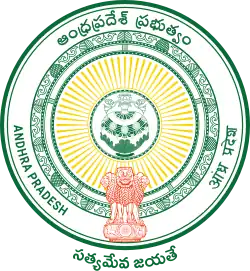Government of Andhra Pradesh
The Government of Andhra Pradesh, or Andhra Pradesh Government abbreviated as GoAP, is the state government for the Indian state of Andhra Pradesh. It is an elected government with 175 MLAs elected to the Legislative Assembly of Andhra Pradesh for a five-year term. The Government of Andhra Pradesh is a democratically elected body that governs the state of Andhra Pradesh, India. The state government is headed by the governor of Andhra Pradesh as the nominal head of state, with a democratically elected chief minister as the real head of the executive. The governor who is appointed for five years appoints the chief minister and his Council of Ministers. Even though the governor remains the ceremonial head of the state, the day-to-day running of the government is taken care of by the chief minister and his Council of Ministers in whom a great deal of legislative powers is vested.
 | |
| Capital | Amaravati |
|---|---|
| Legislative branch | |
| Assembly | |
| Speaker | Thammineni Seetharam |
| Deputy Speaker | Kolagatla Veera Bhadra Swamy |
| Members in Assembly | 175 |
| Council | Andhra Pradesh Sasana Mandali |
| Chairman | Koyye Moshenu Raju |
| Deputy Chair | Zakia Khanam |
| Members in Council | 58 |
| Executive branch | |
| Governor | S. Abdul Nazeer |
| Chief Minister | Y. S. Jaganmohan Reddy |
| Deputy Chief Minister | |
| Chief Secretary | K S Jawahar Reddy, IAS[1] |
| Judiciary | |
| High Court | Andhra Pradesh High Court |
| Chief Justice | Dhiraj Singh Thakur |
Governance
Executive
The Government of Andhra Pradesh is a democratically elected body with the governor as the constitutional head. The governor who is appointed for a period of five years appoints the chief minister and his council of ministers. Even though the governor remains the ceremonial head of the state, the day-to-day running of the government is taken care of by the chief minister and his council of ministers in whom a great deal of legislative powers is vested.
Employees
State has about 8 lakh employees. This comprises 4.3 lakh regular employees, 1.3 lakh employees at village and ward secretariats, 2 lakh contract and outsourcing employees, apart from more than 60,000 employees working in corporations and public sector undertakings.[2]
Legislature
The Andhra Pradesh Legislature is currently bicameral consisting of:
- Sasana Sabha: 175 members (MLAs)
- Sasana Mandali: 58 members (MLCs)
Judiciary
High Court of Judicature at Hyderabad was the highest court of appeal at the state level till 2019. After Andhra Pradesh High Court was inaugurated in Amaravati on 1 January 2019, it became the High Court for the State of Andhra Pradesh. It has subordinate Civil and Criminal Courts in every District.[3] Decisions of the High Court of Andhra Pradesh can be appealed in the Supreme Court of India.
Emblem
The emblem consists of “Dhamma Chakra" (Wheel of law), decorated with a string of triratnas alternating with pinnate leaves and precious stones. Three circles of decorative beads surround the wheel. “Purna Ghataka” (The vase of plenty) is at the hub of the wheel. The national emblem is at the bottom. The word ‘Andhra Pradesh Prabhutvam’ (Government of Andhra Pradesh) in Telugu script is at the top. It is flanked by the word "Andhra Pradesh" written in English and Devanagari lipi. The word 'Satyameva Jayathe' in Telugu scripts appears at the bottom.[4][5]
References
- "Adityanath Das to be next Chief Secretary of Andhra Pradesh". @businessline. 23 December 2020. Retrieved 9 January 2021.
- "Only 1 lakh of total 8 lakh govt. employees in Andhra Pradesh have downloaded facial recognition attendance app, suggests Google Play Store". The Hindu. 17 January 2023. Retrieved 26 May 2023.
- Judicial Directory. Hc.ap.nic.in. Retrieved on 9 January 2012.
- "Coat of Arms- Emblem of Government of Andhra Pradesh" (PDF). Government of Andhra Pradesh. 14 November 2018. Retrieved 16 June 2023.
- "About General Administration Department (Links for emblem and other state symbols)". Government of Andhra Pradesh. Retrieved 16 June 2023.
External links
- Andhra Pradesh State Website Archived 20 September 2022 at the Wayback Machine
- NIC, Andhra Pradesh